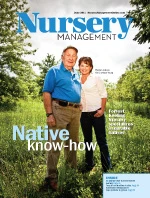 Look for the bands on the antennae to identify a brown marmorated stink bug. Look for the bands on the antennae to identify a brown marmorated stink bug.
It seems like every time we turn around there is a new pest, and today is no exception. But this pest is a little different than the others. Normally when we get a pest problem, we only hear about it within our industry circle. This time we are dealing with a celebrity—this pest has made headlines in major newspapers and on TV.
The brown marmorated stink bug (Halyomorpha halys, BMSB) has been a sleeping giant just waiting for the right conditions to allow its numbers to take off. First reported in the Lehigh Valley of Pennsylvania in 1998, it was thought not to be of any major economic importance. Then it started invading residences and businesses. This unwanted roommate was then deemed a nuisance pest, but still not a lot of focus was put on it. In 2009, commercial peach and apple growers began to notice some damage from BMSB, and by 2010 it seemed the BMSB was affecting several more crops and had also moved into new states.
On to ornamentals
The damage BMSB causes in fruits and vegetables is quite obvious, and has resulted in economic loses for farmers. It seems that fruits and vegetables were not enough to satisfy the appetite of this foreign invader, and it is now moving into ornamental production. In ornamental horticulture crops it is unknown at this point whether the damage will cause significant economic loss. The BMSB feeds on more than 56 genera and more than 80 plant species. It feeds on different sites on ornamentals, from berries on serviceberry to the trunks of maple trees.
Identification
The adults look very similar to other stink bug species. The easiest way to tell them apart is to look at their antennae. They have banded antenna where most others have solid colored ones. Their bodies are brown and have the classic shield shape. They have piercing, sucking mouth parts that poke into the plants to feed. When disturbed or squashed, they emit a foul-smelling odor.
Biology
Similar to native stink bugs, BMSBs overwinter as adults and seek harborages in cracks and crevices in the fall. These protected areas can be natural such as tree bark, or artificial such as in and around buildings. Because of the large numbers of BMSB invading residential and commercial buildings, the owners have taken notice and will try almost anything to remedy the problem. Unfortunately, there is not much that can be done once the BMSB is inside. There are light traps to help trap the adults, but it will not keep them out.
In spring, the adults will start returning back outside or come out of their hiding places. They will mate and lay eggs through the summer months. Their eggs are laid in groups of 20-30. When they first hatch they are black and look similar to ticks. After their fist molt, these stink bugs start to take on more of the classic stink bug look. After five molts, they’re adults.
Control options
Research is continually going on for this pest. And research continues to show that biological control is going to be the long-term strategy to control this pest. So far, U.S. native beneficials have not significantly controlled BMSB populations. USDA researchers have identified four parasitic wasps in the genus Trissolcus from China that lay their eggs in BMSB eggs. During the next two years, these wasps will be evaluated for their effectiveness in quarantine facilities in Delaware.
Until evaluations on those parasitic wasps are complete, insecticidal applications are a grower’s only option. And these bugs can be hard to kill. Many of the products that provide control can be highly toxic to beneficial insects, interrupting ongoing pest management programs.
Research results
Tracy Leskey and a team of researchers at the USDA’s Agricultural Research Service in Kearneysville, W.V., treated glass surfaces using intermediate to high label rates, allowed them to dry for 18 hours, placed 30 BMSBs on treated surfaces and then followed their fate for seven days. They assessed whether BMSB was alive, moribund (point of death) or dead initially, and then assessed longer-term effects. This information was converted into a lethality index (0 to 100).
Thomas Kuhar and colleagues at Virginia Tech, dipped filter paper and a single green bean pod in insecticide solutions based on label rates delivered in 100 gallon per acre. The treatments were allowed to dry for about half an hour before BMSB adults or nymphs were exposed to them in petri dishes. Percent mortality and morbidity were assessed 72 hours later.
The products and active ingredients which gave a lethality index of greater than 85 or exhibited 85 percent mortality or higher are shaded in Table 1 (Page 56). These include acephate, acetamiprid, bifenthrin, chlorpyrifos, cypermethrin, dimethoate, endosulfan, malathion, methidation, methomyl, permethrin and combinations of pyrethroids and neonicotinoids. However, two neonicotinoids exhibited higher mortality in Wuhar’s assessment than in Leskey’s. Acetamiprid and dinotefuron may be good candidates to include in field efficacy experiments.
Trapping the BMSB is another tool currently being researched. Specially-designed traps have been baited with the aggregation pheromone of the Asian brown-winged green bug, Plautia stali.
IR-4 will be sponsoring several BMSB research projects in the Northeast. And the University of Maryland Cooperative Extension will continue to research the effects of this pest in ornamental horticulture production.

|








